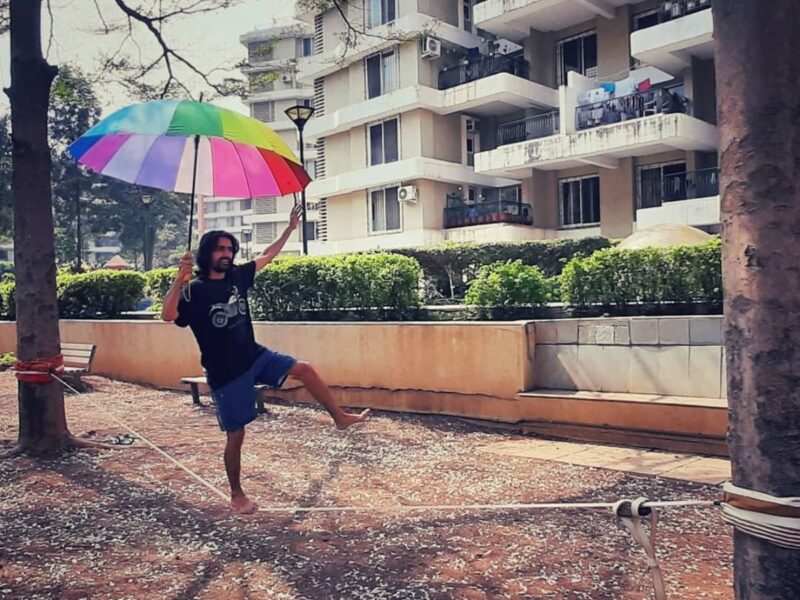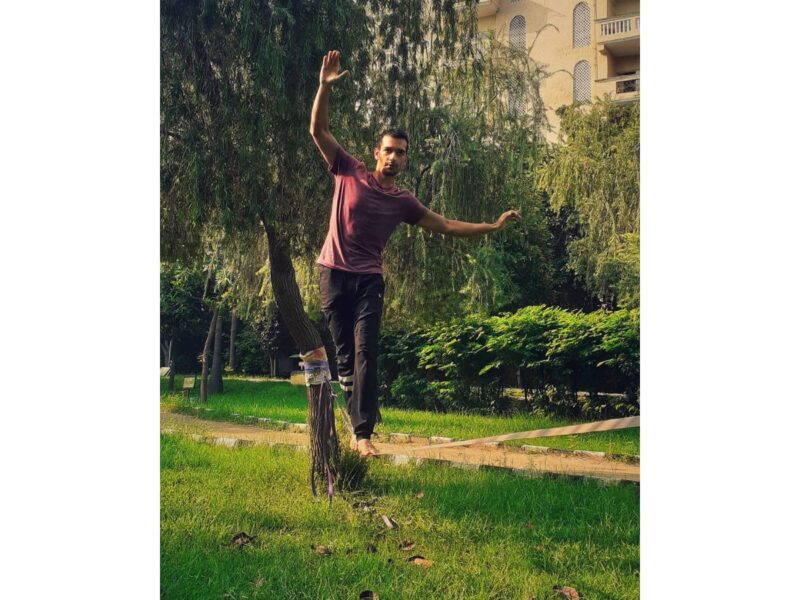“Welcome to the circus!” says Faaris Fawaaz, co-founder of the Delhi Slackline Community, as he does a round of introductions in the park near Muhammad Shah’s tomb at Lodhi Garden. A number of activities are taking place at once: there are slackliners meticulously walking on a suspended rope, acro yogis effortlessly performing different poses and people exercising with an Indian club. Soothing music in the background adds to the overall atmosphere.
Radhika Agrawal, an aerialist and co-founder of the community, takes two novices to the smallest of the three slacklines available in the area. She explains the different techniques of walking on the rope.
“Just keep your hands high in the air and stomach tight. Always look upwards and don’t think about anything”, says Agrawal as she helps the first-timer who is struggling to calm his trembling foot on the rope. The newcomer stays poised on the rope for a second and then tumbles down. “Finding balance is harder than walking”, Fawaaz remarks as he explains how to master the art.

Slacklining is a sport that involves walking on a rope suspended between two trees. It looks like tightrope walking that we see in melas, but there the rope is usually round. Here the rope is flat, made of polyester or nylon and gives a different feel. Also, slackliners don’t use poles to keep their balance.
“When you’re setting up a slackline, it’s called rigging. When you rig a slackline, the tension — how loose or tight it is — makes all the difference, besides of the material which it’s made from”, explains Fawaaz. “So it’s a lot different from tightrope walking,” he adds.
Fawaaz and Agrawal founded the Delhi Slackline Community back in August 2020. Agrawal had learnt it in Mumbai and wanted to continue the sport. Fawaaz had developed the interest and skills from the ‘original group’ — which is now called Slacktivism, a famous slacklining community in the national capital.
Their weekly meet-up called Slack Sundays evolved with every meet. A number of beginners were drawn to the sport and became ardent participants. “There was a lot of intrigue around it when we started. They used to call us Circuswallahs. A lot of people — kids, uncles, young folks — started coming in. They would soon become fond of us”, says Agrawal.

Every Sunday brought in a new person ready to try the game as people would brought friends to participate. “We just wanted to create awareness about the sport because it’s very new. Our Instagram page also helped us to reach out to a wider circle. People would share our stories and come join us”, she adds.
No money is charged for the activity. “People come here to chill and relax,” Agrawal says. “It’s not something that gives you muscle or makes you slim. It’s more of a meditation, or being a part of a community.”
Sonakshi Mittal, 27, has been slacklining for over a year now. She headed to the park as a sort of ‘refuge’ after the lockdown. “I joined it because of the new people I met. As a person who likes movement in general, slacklining for me is fun”, she says.
Speaking on the learning process, she says, “I think for the first few months I just came here to chill and meet new people. I would of course walk the line but I was not getting any better at it. Then one fine day I started walking and I was ‘Oh okay, maybe I was learning this the whole time.’ It never felt like a class.”

The community wants the sport to grow organically — without the involvement of any money or pressure. “Like Fawaaz passed down his knowledge to me, I would pass it to others. And I want the community to grow like that. We are people who travel a lot and do not stick to one place. So, even in our absence, we want it to grow”, Radhika says – a sentiment which Sonali and Fawaaz echo, adding that the community should become self-sustaining.
Both Fawaaz and Agrawal have personal goals with the sport and are currently trying to excel at highlining – slacklining at bigger heights. Now that’s a different ballgame altogether.
For more stories that cover the ongoings of Delhi NCR, follow us on:
Instagram: instagram.com/thepatriot_in/
Twitter: twitter.com/Patriot_Delhi
Facebook: facebook.com/Thepatriotnewsindia





